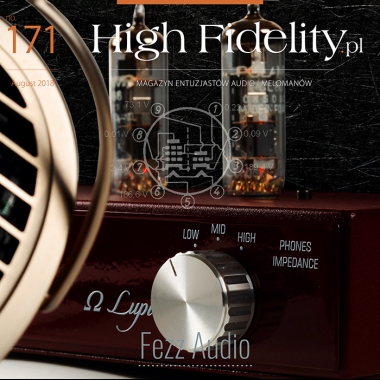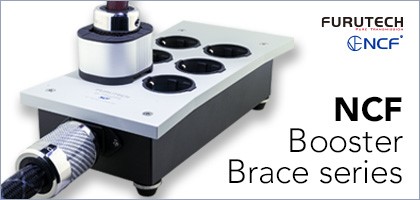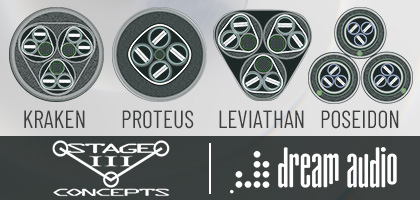No. 242 July 2024
- COVER REVIEW: Ferrum WANDLA GOLDENSOUND EDITION ⸜ digital-to-analog converter » POLAND
- AUDIO SHOW ⸜ coverage: HIGH END 2024 ⸜ Munich » GERMANY
- REVIEW: Daniel Hertz MARIA 350 ⸜ integrated amplifier » ITALY
- REVIEW: Lumin P1 MINI ⸜ file player » HONG KONG
- REVIEW: Thunder Melody AC FEMTO BLACK (2024) ⸜ AC power cable » POLAND
- REVIEW: Laiv HARMONY DAC ⸜ digital-to-analog converter » SIGAPORE
- MUSIC ⸜ review (in Polish): Three Blind Mice: KOSUKE, MOTOHIKO, YAMAMOTO ⸜ remaster 2024 • SACD/CD » JAPAN


|

|
|
THE SECOND LIFE OF THE AUDIO BLU-RAY
We live in transition times and who knows how things will actually go. Here and now, however, I must say that it is difficult for me as an audiophile and music lover, to accept the fact that the cover, disc, printed description are ripped from my hands. As it turns out, I am not the only one who feels this way, and press conference premiere (the DMT3.7 premiere was in Munich 2015) of high-end optical disc and files transport (CD, SACD, DVD and BD) of the French company JMF AUDIO, which took place during this year's Hifideluxe show at the Mariott Hotel in Munich was intended for us. Prepared together with the 2L label it was something of a "new beginning" for the Blu-ray Pure Audio format, that is a Blu-ray disc only with hi-res (24/192) PCM audio recorded on it. But let's start from the basis. | Apple HomePod HomePod seems to be a dream device and, remembering Apple's marketing mastery, and that almost all of their products sold at least very well, everyone expected this product to win the market immediately. As we read, the data from the beginning of the sale were optimistic, however it didn't last long. For the first ten weeks, the HomePod loudspeaker accounted for 10% of the market of smart speakers, 14% for the Google Home, and all awards were actually collected by Amazon Echo with a 73% market share. 
Image Apple HomePod seems to be a dream device and, remembering Apple's marketing mastery, and that almost all of their products sold at least very well, everyone expected this product to win the market immediately. As we read, the data from the beginning of the sale were optimistic, however it didn't last long. For the first ten weeks, the HomePod loudspeaker accounted for 10% of the market of smart speakers, 14% for the Google Home, and all awards were actually collected by Amazon Echo with a 73% market share. Then it got even worse and after a few weeks the sale of Apple products dropped to 4%. The Bloomberg Agency revealed that already in March, so less than two months after its debut, Apple accepted that the number of speakers sold will be smaller than initially expected. And market forecasts were adjusted to this new reality, and as a result of their analysis the number of orders from factories was reduced. Of course, you can not completely rely on such data, because there is an acute war in this market segment. However, this information was confirmed by the analysis of Deutsche Bank, according to the buisinessinsider.com "brutal analysis". So it seems to be true ... There are many reasons for sales going slower than expected, but among the most important ones was the late launch, which means giving Christmas shopping opportunity to competitors for free, and the other one was closing the system in Apple's micro-cosmos - HomePod works with all smartphones... provided they are made by Apple. Some point out also that Siri is not as smart after all - and regardless of what the company wanted to convey, the voice assistant is the most important function of "intelligent" speakers. The high price (PLN 1,700) was also a significant factor in the lack of success. 
Image Apple To tell you the truth, I do not care. I would like to think that it's not because I do not understand this type of products, as it is not so difficult, or that I can not keep up with trends, because uncritical submission to market suggestions is sometimes stupid. The thing is, I, Wojciech Pacuła, 45, do not need such a product. Who knows, maybe I will change my mind some day, it may turn out some that the voice controlled system will prove to be helpful, but not yet. So why do I even write about it at all? Because it is the future. And also because our industry - I think about the audio perfectionist industry - does not know what to think about it. In a way, we are like a man with a split personality. A few months after the premiere of HomePod, the Blu-ray disc transport dedicated mainly to the playback of Blu-ray Audio discs were introduced, promoted by one of the most respected music labels - the 2L The Nordic Sound. In this way, two extremely different ways of thinking about music at home and its role in our lives met. | Two paths "Voice assistants", because this these products are often referred to, are a combination of "artificial intelligence" and systems used to play music, usually streaming the signal from a smartphone or one of the streaming services. That's how most people listen to music today, not just young people. As we read in the article by Cliff Joseph Talking 'bout resolution, the success of this type of music distribution is unquestionable („Hi-Fi News” No. 06, June 2018). 
The 2L released first audio Blu-ray discs already in 2008 For the people looking for not only convenience but also high-quality sound, new possibilities open up, as more and more streaming services offer high resolution files - either, like Quobuz, in lossless FLAC 24/192 files, or as Tidal encoded in MQA; the latter option is being considered also by Deezer and Nugs. The real breakthrough, however, will come only when the market key players decide on such a step, that is Spotify and iTunes. But this is only one of the possibilities. The second one involves physical media. As it turns out, the publishers achieved a lot of success in this field, because they bred a kind of "vinyl bubble", creating a retro trend, ideally suited to what is happening in the furniture and interior design industry. I am sure that the bubble will break after some time and it will turn out if the vinyl has been permanently “grafted” or if it was only a temporary trend, leaving behind a heritage in the form of refreshed specialized audio mainstream. 
JMF Audio DMT 3.7 Blu-ray Transport. image JMF Audio Whatever you think about it, vinyl is a part of a culture that links music with sound and a specific culture of listening to the music. That's exactly what Mr. Laurient Fusilier, the owner and chief designer of the French company JMF Audio follows. At the Hifideluxe • Munich 2018 show, the company's room was a place where the latest achievements in the music playback of Pure Audio Blu-ray discs were presented, using the new, high-end JMF Audio DMT 3.7 Blu-ray transport. Although it reads on the manufacturer's website that it was the "premiere" of the format, it is worth knowing that it has been with us since 2012, and without the appropriate logo since 2008. | Blu-ray Audio 
Before move to its description, a few words should be given to the format in question. This is not the first meeting of "High Fidelity" readers with this kind of discs, because we devoted the entire May 2015 editorial (HF | No. 132; more HERE) to that topic. Blu-ray Audio is simply a Blu-ray disc with a high-resolution PCM music signal, usually only with audio, no image. The idea was to use it like a Compact Disc and Super Audio disc CD, it is without a TV screen. This is not the first such operation, i.e. an attempt to use a consumer, mass medium for our own purposes. The Compact Disc was a format that was conceived as an audio format. Although the video version also appeared, it did not gain wide support. It was different from audio and DVD format. The format presented on March 19th 1997 was designed as the successor to the VHS cassette, so it was a strictly visual format. It's just that the DVD-Video specification allowed to save the sound in Dolby Digital and DTS lossy formats, but also in stereo PCM format with a resolution of 24 bits and a sampling frequency of up to 96 kHz. In the late nineties, Chesky Records, Hi-Res Music, and Classic Records used this opportunity and released dozens of DVD titles exclusively with sound, a version they called DAD - Digital Audio Disc. 
A variation of the DAD disc by Classic Records: HDAD (Hybrid DVD-Audio Disc). The company took advantage of the unique properties of the DVD format and released a two-sided disk - on one side there was the DVD-Audio 24/192 version, on the other DAD 24/96; on the photo Alan Parsons Project, Eye in the sky . This simple and thus flawless idea to provide music to music lovers encoded in high definition, however, disappeared as quickly as it appeared - on the one hand due to the lack of high-end DVD players, and on the other by the appearance of a DVD format extension, that is DVD-Audio. You probably know the history - because Sony and Philips prepared a competitive format - Super Audio CD - there was a so-called "Format wars", as a result of which DVD-Audio ceased to exist, and SACD assumed the role of ultra-niche format used by very few (more about SACD HERE and HERE). DAD discs also became a victim of this process. 
A beautiful box with Beethoven symphonies from the Deutsche Grammophon record label with two CDs and all symphonies on a single Blu-ray Audio disc. Photo Universal Music Company In the summer of 2013, Universal Music Group announced the creation of a new format: High Fidelity Pure Audio Blu-ray. While its name is long, the short description is: it's just a Blu-ray disc with audio only. Using the capacity of BD disks, three versions of the same stereo material were recorded on it: an uncompressed PCM 24/96 signal and lossless compressed DTS Master Audio and Dolby True HD. Thanks to the huge library of UMC titles, archived as hi-res files, the potential impact on the market could be really big - at least for the audiophile market. 
Pure Audio Blu-ray discs by 2L. photo: 2L But this was not the first attempt of this type, because already in 2011, as I wrote earlier, there appeared an almost identical idea called Pure Audio Blu-ray by msm-studio group, a production company from Munich, and 2L – record label from Scandinavia(published in 2011 at the AES Audio Engineering Society - color keys used for screeen-less stream selection). The assumptions in both cases are the same, although for Pure Audio BD both the 24/96 and 24/192 signals could be recorded. The control was to look similar to that of the CD, and the choice of the appropriate signal version was made using the colored buttons on the remote control. |
| JMF Audio DMT 3.7 Already then, in 2012, I thought it was a missed opportunity and that although the format itself was a great way to play music from a high-resolution signal, the market clearly pointed to hi-res files - which ultimately happened in the form of streaming rather than buying and downloading files to the hard disk. This was not the only reason for this. It decided about failure on the part of the consumer market, but from the side of the specialist market much more important was the lack of specialized, high-end Blu-ray players. In some ways, the niche was filled by Oppo and Esoteric, but it still was not something that could compete with the best Compact Disc and Super Audio CD players. The DMT 3.7 discs and files transport(Digital Media Transport) by JMF Audio is the first of its kind. The basis of the new device is the BDPM1 mechanics, developed independently by JMF. When we watch it, it is impossible not to notice that its mechanical construction resembles what we know from the Esoteric and Accuphase NEO-VRDS transports (it was SACD/CD only disc however). It is about maximum rigidness, the fastest possible drainage, and if it not possible, damping vibrations and a reliability. Its structure is a massive aluminum block weighing 2 kg made with 1/100 mm precision, mounted on a multi-layer decoupling system, and the whole rests on a ball system, known for example from the Stacore platform or the Franc Audio Accessory feet. The entire device weighs 30 kg. Although the main assumption was to create the best player for BD Audio, the DMT 3.7 is a multi-format and multiplatform transport. It plays BD, DVD, SACD, CD formats as well as files, including DSD. And yet it looks like a classic top-loader - and that's probably what it was about, to create a device that would look familiar and remind us of high-end CD and SACD players. It is not the appearance itself that it is about - its lid is part of an advanced system that presses the disc. It is made of carbon fiber. In order to cope with the air set in motion by the spinning disk, the chamber is made so that the influence of the air on the disc is limited. Let me add that the lid is hydraulically lifted and oil damped.  LAURENT FUSILIER | JMF Audio 
From the left: Christoph Diekmann - Pure Audio Recordings - holds the catalog for 2018 Stefan Bock from the msm-studios company holds the Pure Audio Alessandro Quarta Blu-ray disc, Laurent Fusilier, the owner of JMF Audio, holds in his hand a Grammy 2017 nominated Blu-ray Pure Audio disc by Ensemble96 released by 2L, recorded using the JMF Audio PCD 302 power supply conditioner. Photo JMF Audio WOJCIECH PACUŁA: Please tell something about yourself and your company. He studied the typical sound of passive components, the sound of metals for the audio signal path... His approach to power amplifiers can be summarized in three points: massive energy reserve for instant delivery to the speakers on fortissimos, ultra short signal path with direct DC coupling and precision balanced input stage, high voltage multiple output transistors for lowest distortion and best control. Naturally stable behavior not relying on feedback loops. The power handling and natural sound were so impressive that they were selected by Tom Hidley, the most influential recording studio designer, since comparisons to the famed reference power amplifiers in Nashville studios in 1989. My brother (Arnaud) and I (Laurent) were immersed in technology, audio and music from a very young age. I got my hands on (and inside) the only computer in the company when I was 10 years old and built my first audio equipment from scratch at about 14. It was a guitar preamplifier, as my brother got on playing the guitar. As teenagers, we designed and built a large sound system and did quite a few sound reinforcement services for concerts. 
JMF Audio DMT 3.7. photo JMF Audio Naturally my brother and I did scientific studies and graduated in mechanical engineering and electronic engineering respectively. I joined JMF Audio in 2004 after I designed my first DAC in 2003, which probably was the first 768kHz DAC ever built. When did you start thinking about a hi-res player? Then we discovered the new Blu-ray Pure Audio format, with quite a few releases already available. I thought this was the format we had been waiting for: high definition, physical media, no computer fuss. The first evaluation was made with Blu-ray from Jan Gunnar Hoff "Living" 2L. It showed great potential. From our earlier evaluations, we knew we could get a more desirable sound with a spinning disc, so I figured we had to support this format while enhancing CDs and SACDs, thus to design the dream transport as the last product to complete the JMF Audio line. What was your goal? Do you really think that physical disc is a future in a "streaming" world? 
BDPM1 mechanics. photo JMF Audio What is the upside of BD Audio disc vs streaming/files? Your transport is unique – is it of your own design? What was the starting point? Next we eliminated all tray/moving loader mechanisms for the same reasons. Thus the ultimate JMF Audio transport would be massive, heavy, decoupled and feature top loading. At that point we already forgot about making it relatively affordable... The optical mechanism was then residing on the composite base decoupled with JMF Audio purpose developed cone-ball feet. As I was pointing out the remaining influence of vibrations on optical pick up, my brother Arnaud, mechanical engineer, looked at it and said: I will design a massive block. Needless to say I was a little skeptical. I knew he would manage but I feared the number of prototypes and cost of development since we had to recall aeronautic processes to achieve the desired machining precision. A precision we cannot reach with the machines at our facility. He made it. It is expensive. We approved. Nothing is too good for the music we love. Does DMT3.7 play also DVD-Rs with files? – like the Reference Recordings Hrx? 
If I read it correctly, you are firm fans of PCM - right? Why, I mean, what's flawed in SACD format that makes you not like them? SACD were supposed to offer an increased bandwidth, but it is filled with high level noise... Such a noise can have dramatic influence on the next analog stages, by intermodulation distortions, making converters and analog circuits deal with high speed signals, saturating tweeter. To reduce the annoyance, SACD players had to feature an analog 50kHz low pass filter... Thus reducing the advantage of an improved impulse response over CDs while still leaving noise between 20kHz and 70kHz at high level... Some manufacturers recalled noise scrambling techniques, which modifies the original signal while rejecting the noise higher in frequency... Another aspect is jitter. With PCM, we have developed means of greatly reducing jitter in a very musical way in the DMT 3.7 transport and in the DXC2.2 MKII DAC. Jitter remains an issue in DSD... So for now JMF Audio takes SACD for what it is: a disc with higher definition audio content, and process the stream in multi-bit, reduce the quantization noise, convert as high as 705KHz for best musical rendering. Back in the late 90's, record companies feared CD copy. Sony promoted the SACD as impossible to copy and got acceptance. At the same time, the president of Sony, who was an audiophile, promoted their new digital mixing consoles for world class studios. Mixing consoles, which were PCM, as no processing can be applied to a DSD stream... Indeed DSD may be good for storage but does not allow a digital recording work flow. Engineers wishing to record and produce in digital have always worked PCM. Recording in DSD is possible but level adjustments, mixing, equalizing, mastering, requires signal to be converted back to analog, thus accumulating the noise, jitter and non-linearity issues... Music for computers allowed DSD x2, x4 to emerge... However it has to be noted that the great majority of studios work on PCM on 24/96kHz, less commonly 192kHz. The added value from 96kHz to 192kHz is minimal. The industry standards are here. And we like to say that the only important thing is music; we just aim at serving it to the best of our abilities.  | Physical disc it is... As I've said, it is not only the transport of Blu-ray audio discs, it also offers the reproduction of classic, i.e. video BDs, as well as SACDs and CDs and playback of files from local and network storage, including Tidal. This is a clever move, because streaming is an important part of the musical experience and a lot of music will come from this type of source. If, however, we would like to listen to a disc, then we can reach for any optical format. And maybe for the first time in our life we will hear most of the recordings exactly as they were mastered, without conversion from PCM to DSD, as it happens with most SACDs. 
David Gilmour Rattle That Lock Deluxe version was released on Blu-spec CD2 and Audio Blu-ray with 24/96 PCM signal. There is also some video material on the disc, and in its audio section also some additional remixes Because the truth is that the vast majority of recordings and remasters are made in the PCM digital domain. And even though mathematically the file downloaded from the Internet is identical to the one that was saved on the disc, life shows that file players are still imperfect. And Audio Blu-ray discs offer top-quality sound here and now. We also own something that we buy (unlike in the case of music files). And all are collectors to some extent, right? Wojciech Pacuła |
About Us |
We cooperate |
Patrons |
|
Our reviewers regularly contribute to “Enjoy the Music.com”, “Positive-Feedback.com”, “HiFiStatement.net” and “Hi-Fi Choice & Home Cinema. Edycja Polska” . "High Fidelity" is a monthly magazine dedicated to high quality sound. It has been published since May 1st, 2004. Up until October 2008, the magazine was called "High Fidelity OnLine", but since November 2008 it has been registered under the new title. "High Fidelity" is an online magazine, i.e. it is only published on the web. For the last few years it has been published both in Polish and in English. Thanks to our English section, the magazine has now a worldwide reach - statistics show that we have readers from almost every country in the world. Once a year, we prepare a printed edition of one of reviews published online. This unique, limited collector's edition is given to the visitors of the Audio Show in Warsaw, Poland, held in November of each year. For years, "High Fidelity" has been cooperating with other audio magazines, including “Enjoy the Music.com” and “Positive-Feedback.com” in the U.S. and “HiFiStatement.net” in Germany. Our reviews have also been published by “6moons.com”. You can contact any of our contributors by clicking his email address on our CONTACT page. |




 |
     |
main page | archive | contact | kts
© 2009 HighFidelity, design by PikselStudio,
projektowanie stron www: Indecity







 hat is the difference between a collector and someone who just gathers some items? Mieczysław Stoch, the hero of the interview you can also read in this issue of "High Fidelity" says that collecting is gathering with sense and purpose (HF | No. 171). And what is listening to music from files and how does it differ from listening to music from physical media? Based on the above definition, one would like to write that listening to music from physical media is listening to music with sense. Although one part of me thinks so, the other part knows that my own experience speaks through me rather than the experience of a larger group of music lovers - people who listen to music with sense, because after all many of them use only files, and young people have never used any other music medium in their lives.
hat is the difference between a collector and someone who just gathers some items? Mieczysław Stoch, the hero of the interview you can also read in this issue of "High Fidelity" says that collecting is gathering with sense and purpose (HF | No. 171). And what is listening to music from files and how does it differ from listening to music from physical media? Based on the above definition, one would like to write that listening to music from physical media is listening to music with sense. Although one part of me thinks so, the other part knows that my own experience speaks through me rather than the experience of a larger group of music lovers - people who listen to music with sense, because after all many of them use only files, and young people have never used any other music medium in their lives. 


